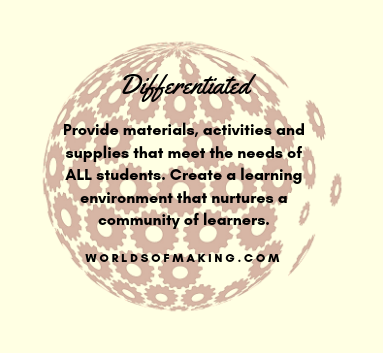In a recent blog post, I presented the 7 Attributes of a GREAT Makerspace. These attributes are meant to serve as a guide for school districts and educators as they plan Makerspaces for their school communities. One of those attributes is that GREAT Makerspaces are DIFFERENTIATED and effectively meet the needs of mixed-ability learners.

One of the things mentioned in that post, was the idea of differentiating the process a student follows to make and create in a Makerspace. Recently, I asked my PLN to contribute to a Padlet that asked them to share the process their students follow for making in their Makerspace. There contributions can be seen below:
As you can see, every Makerspace is different. Some Makerspaces have a predefined process that their students follow and others do not. For me, that is part of the beauty of the Maker Movement in schools. I always say, No two Makerspaces should be exactly alike, because no two school communities are exactly alike. The way schools interpret this Movement is deeply personal to them, and that includes the process for making they have their students follow. A question worth considering still though is:
Do students need to follow a specific process for making and creating in a Makerspace?
We know differentiated instruction is an evidence-based practice for reaching all learners in a classroom. Differentiation need not be limited to a classroom setting, however. A differentiated Makerspace can allow students of all abilities to participate, experience success, and ultimately flourish. Therefore, I believe it has become increasingly important that we consider how we can differentiate the process students follow for making and creating in a Makerspace.
The process a student follows for making in a Makerspace can be differentiated in many different ways. As an alternative to assigning them a specific process, I would like to suggest the following as a starting point:
REFLECT
Help students uncover and articulate the process that they used to make and create. Everyone instinctively uses a process to make and create. After making, have students reflect on their iterative process by asking effective questions, such as:
- What did you make/do?
- What did you do first, second, etc?
- What materials did you use/work with?
- What surprised you during the process?
- What frustrated you? What did you do about your frustrations?
INTERVIEW
Have students interview their peers or maker mentors to help them refine their own making process. The guiding question of their interview should be:
“Where do I see this maker doing something that I can do in my own making process? “
During this interview process, teach students the skill of asking good questions of the person they are interviewing. Post-interview, support students as they reflect on their own making and find a place in their own making process where they can use what they learned through their interview.
GRADUAL RELEASE
Gradually releasing responsibility of a structured making process to eventual learner independence. While a structured process for making and creating in a Makerspace may serve as a good starting point, we can use a gradual release model and thereby transferring responsibility of the process from the teacher onto the student. This allows the teacher to provide varying levels of support and scaffolding for tasks in a Makerspace.
I do believe that an important part of differentiating in a Makerspace includes empowering students to follow their own process for making and creating, rather than attaching a prescriptive process. This type of flexible, self-directed learning will empower as well as enhance all learners’ unique learning abilities.
How have you differentiated in your Makerspace? Share your ideas at #worldsofmaking!






